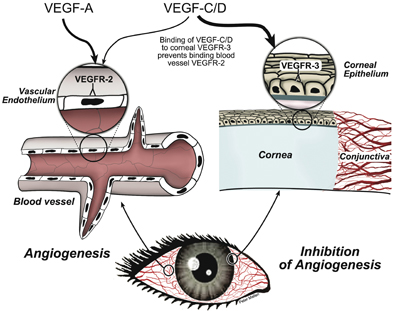Of all the tissues in the body, the cornea has the unusual capacity to function without blood vessels. The lack of blood vessels keeps the eye clear for vision. (Cartilage is the only other type of tissue to lack blood vessels.)
But how can corneal tissue remain healthy and even repair itself without blood vessels? Scientists at the Schepens Eye Research Institute and Massachusetts Eye and Ear Infirmary may have discovered the answer.
The key, they say, is the unexpected presence of large amounts of the protein vascular endothelial growth factor receptor-3 (VEGFR-3) on the epithelial layer of healthy corneas. VEGFR-3 halts angiogenesis by acting as a sink to bind or neutralize the growth factors sent by the body to stimulate the growth of blood vessels, according to their findings, published in the July 25 Proceedings of the National Academy of Sciences.
When injury or infection occurs in other areas of the body, the immune system sends in vascular endothelial growth factor (VEGF) to bind with a protein receptor called VEGFR-2 on blood vessels to trigger vessel growth. Three forms of VEGFA, C and Dbind with this receptor. Two of them, C and D, also bind with VEGFR-3, which is usually found on cells lining lymphatic vessels, to stimulate the growth of lymphatic vessels.
 |
| VEGFR-3 on the corneal epithelium absorbs growth factors (VEGF-C/D), which neutralizes them and prevents them from binding with VEGFR-2 to trigger new blood vessel growth. |
The researchers began to suspect that VEGFR-3 was involved in stopping corneal angiogenesis when they unexpectedly noticed that large amounts of the protein seemed to exist naturally on healthy corneal epitheliuma previously unknown location for the receptor. The researchers were already aware from clinical experience that the epithelium most likely played a role in suppressing blood vessel growth on the cornea, having witnessed blood vessels develop on corneas stripped of their epithelial layers.
They began to theorize that the large amounts of VEGFR-3, in this new, non-vascular location, might attract and absorb all the C and D VEGF, thereby blocking them from binding with VEGFR-2. And, because this binding took place in a non-vascular setting, the growth factors were neutralized. Experiments that they performed using corneal tissue from mice corroborated their theory.
This discovery has far-reaching implications, such as anti-angiogenic treatments for the eye and other areas of the body, the researchers say. Such treatments might even help shrink cancerous tumors fed by rapidly growing abnormal blood vessels.

